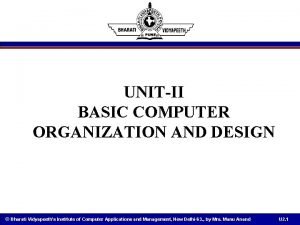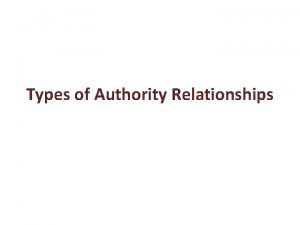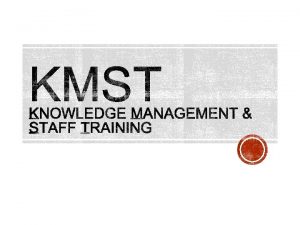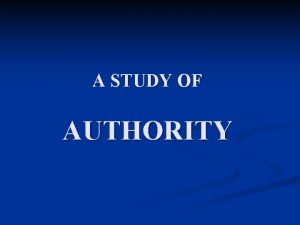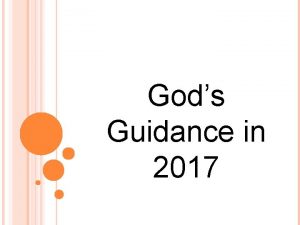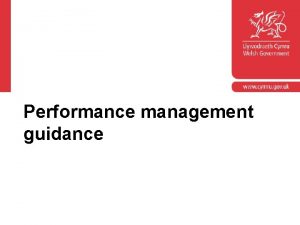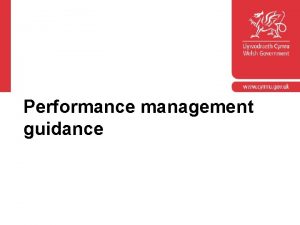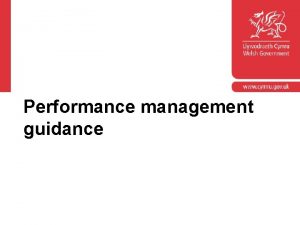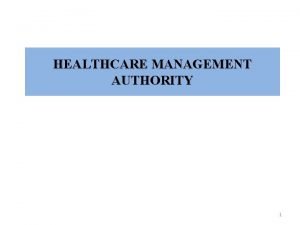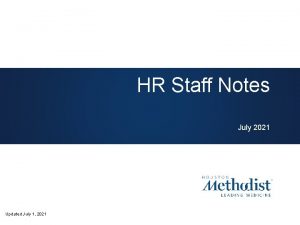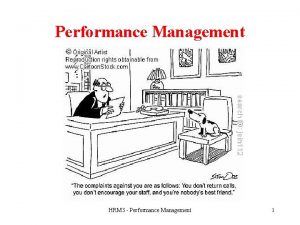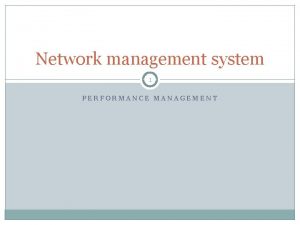Performance Management Performance Review Authority Guidance Updated July






























- Slides: 30

Performance Management Performance Review Authority Guidance Updated July 2012

Guidance Purpose Defines the role of the Performance Management Performance Review Authority (PM PRA) Describes the timeline, structure, process and compliance issues relevant to the PM PRA Provides an overview of how to conduct a statistical review of proposed employee ratings for both closeout early annual and year-end This guidance is a supplement to AP-V 2011, Performance Management, published by the Army. 2

DCIPS Year-End Performance Management Schedule September October Employee submits Self. Assessment November December January Performance Management Process 10/15 Rating Official Completes Performance Evaluation (Employee Performance Plan, including IDP for new Performance Evaluation Period are due) 10/30 Reviewing Official Completes Performance Evaluation Data Administrator Provides DPAT 11/15 Legend Milestone USD(I) Required Due Date Performance Evaluations Communicated to Employees Rating Reconsideration Process 3

ROLES AND RESPONSIBILITIES 4

Role of PM PRA The role of the PM PRA, as outlined in AP-V 2011, Performance Management, is to provide a final review to ensure consistency across Rating/Reviewing Officials and compliance with applicable laws and regulations. 5

PM PRA Responsibilities Performance Rating and Review Process NLT 15 October NLT 30 October Employee Self-Report of Accomplishments Rating Official Evaluation of Performance NLT 15 November Propose Final Rating to Employee Reviewing Official Review PM PRA Final Review NLT 25 November Final Rating available to Bonus Group Manager PM PRA Activities Primary Purpose: Statistical review to ensure consistency and performance differentiation across the organization Must be complete no later than 45 days after the end of the rating period. Concurrent with reviewing officials’ review, PM PRA conducts a statistical review of the data for consistency across rating officials and reviewing officials. Analyzes data within various dimensions such as directorate, occupational series, rating and reviewing officials and grades. The PM PRA review may run concurrently with reviewing official action, at the discretion of the Command. 6

PM PRA Responsibilities (cont’d) Performance Rating and Review Process NLT 15 October NLT 30 October Employee Self-Report of Accomplishments Rating Official Evaluation of Performance NLT 15 November Propose Final Rating to Employee Reviewing Official Review PM PRA Final Review NLT 25 November Final Rating available to Bonus Group Manager PM PRA Activities (cont’d) Rating adjustments may be directed through the PM PRA review process to the reviewing official. The PM PRA may also make the change him/herself if rating officials refuse. Provides final review of statistical data. The PM PRA may request additional support or explanation from reviewing officials and can change an individual’s evaluation of record if necessary. Resolves employee requests for reconsideration of evaluation of record in accordance with Administrative Reconsideration Guidance. Determines the modal rating to be used for specially-situated employees when a presumptive rating (the last DCIPS rating of record) for the employee cannot be used. 7

Completing the Performance Evaluation Process Final Review Process Final Rating to Employee Reviewing Official Review PM PRA Final Review NLT 25 November Final Rating available to Bonus Group Manager Reviewing Official Activity Any evaluation of record finalized before completion of the PM PRA review are invalid and must be submitted to the PM PRA for review in accordance with DCIPS policy. After PM PRA has completed its statistical review, the reviewing official approves the evaluations of record in the PAA Tool which facilitates the transfer of the data to begin the Performance-Based Bonus process. This action completes the performance evaluation process. 8

PM PRA Delegations of Authorities PRA Level Delegation of Authority Army PM PRA The HQDA ADCS G-2 is the PM PRA authority for Army. The Army PM PRA is the final review authority for official reconsideration of the evaluation of record when the employee disagrees with the Command PM PRA decision. Command PM PRA The commanders of the ACOMs, ASCCs, DRUs and AASA serve as the Command PM PRA for their respective command. They establish their respective PM PRA structure through the appointment of Organizational PM PRA(s). Organizational PM PRAs may be specific individuals or panels (headed by a chairperson) that report back to and provide recommendations to the PM PRA. Command PM PRAs may appoint Organizational PM PRA’s within their subordinate organizations (but not reconsideration authorities) to no lower than Commanders (Colonel – 06 and above, or civilian equivalent). Commanders of ACOMs, ASCCs and DRUs may further delegate the authority to serve as the Command PM PRA to their Deputy Commander or Command Chief of Staff. For Headquarters, Department of the Army, the AASA may further delegate the authority to the Deputy Administrative Assistant to the Secretary of the Army or to the Principal Officials. 9

Army PM PRA Responsibilities Army PM PRA (HQDA ADCS, G-2) Ensures consistency of performance management policies across component. Ensures compliance with merit system principles. Serves as the Army PM PRA for final independent review and decision of employee’s performance evaluation rating of record when an employee challenges decision by Command PM PRA. 10

Command PM PRA Responsibilities Command PM PRA Provides an organizational perspective for the review of performance ratings to ensure consistency of DCIPS performance management practices: Determine if a PM PRA panel will be used (if appropriate), appoint panel members and serve as chairperson. Notifies employees of their PM PRA structure no later than 90 days prior to end of rating cycle. May review all evaluations of record, including any closeouts, to ensure consistency across rating officials and reviewing officials in compliance with merit system principles, applicable laws and regulations. Review may be conducted concurrent with reviewing official’s action at discretion of command. Determines inconsistencies, suggests corrective action (where appropriate) and/or makes changes (if necessary) prior to approval of ratings by the reviewing officials to ensure integrity of performance evaluation process. PM PRA can, and must, send back proposed evaluations of record if ratings or narratives do not support the proposed evaluation of record or if there is concern regarding the merit of the proposed evaluation of record. PM PRA may seek to resolve inconsistencies with responsible reviewing officials and may consult with legal counsel to ensure his or her actions conform to law. Completes performance evaluation review process no later than 45 days following end of rating period (15 November). Approves the modal rating for specially situated employees at the first level of PM PRA review when presumptive ratings cannot be used. Reviews reconsideration requests by employees and rules on formal reconsiderations. 11

Organizational PM PRA Responsibilities All responsibilities of the Command PM PRA with the exception of reviewing reconsideration requests. The following are additional responsibilities of the organizational PM PRA: Ensures employee reconsideration requests are forwarded to Command PM PRA for resolution. Provides statistical data to Command PM PRA for reporting purposes. Organizational PM PRA 12

PREPARATION 13

Preparation Determine PM PRA Structure: – The Commanders of ACOMs, ASCCs, DRUs and the AASA serve as the Command PM PRA, unless they delegate the authority to their Deputy Commander or Command Chief of Staff. For Headquarters, Department of the Army, the AASA may further delegate the authority to the Deputy Administrative Assistant to the Secretary of the Army or to the Principal Officials. – The Command PM PRA may establish their respective PM PRA structure through appointment of Organizational PM PRA(s). Organizational PM PRAs may be specific individuals or panels (headed by a chairperson) that report back to and provide recommendations to the PM PRA. Panel members might include DISES, DISLs, Senior Intelligence Officers, Reviewing Officials. Define Command Timelines: – Each Command may choose to set up its own timelines for completing each stage of the rating process, as long as all ratings are approved by 15 14 November.

Preparation (cont’d) Define Command-specific review processes: – Performance Management business rules can be defined to specify review procedures and requirements. Administrative Compliance: – Each member of the PM PRA review process should sign a nondisclosure agreement. 15

Pre-decisional Prohibited Actions No forced rating distributions: – Strictly forbidden. – Must be communicated to employees to prevent perception of forced distributions. No demographic analysis performed at this stage in the process: – Demographic analysis will be conducted after the process is completed. 16

STATISTICAL REVIEW PROCESS AND ANALYSIS 17

Purpose of Statistical Review Process Complete a high-level statistical review of the data to ensure consistency of rating distributions across the organization. Identify anomalies or skewed rating distributions. Review rating distributions to ensure performance rating distinctions. Review any rating discrepancies with reviewing officials. 18

Examples of Rating Analysis The PM PRA may wish to examine the following in its statistical review of ratings to ensure consistency across the organization: üRating distributions, organization wide and by bonus group üRating distributions between like bonus groups üAverage ratings üLevel 1 and 5 ratings (by individuals) 19

DPAT Tool to Assist PM PRA The DCIPS Performance Analysis Tool (DPAT) is used to assist PM PRAs in reviewing rating distributions – It is an Excel-based spreadsheet tool that allows each Command to examine ratings data in a variety of ways. Each Command will have Data Administrators trained in the use of the DPAT: – There are standard DPAT worksheets that the PM PRA can use to review ratings across the organization. 20

DPAT Sample Rating Statistics Worksheet 21 21

Typical DCIPS Rating Distribution This graph represents a potentially ordinary DCIPS rating distribution. An ordinary rating distribution is one where there are more Level 4 ratings than Level 5 and more Level 3 ratings than Level 4 and very few Level 1 and 2 ratings. This rating distribution is not mandated (or forced); this is the most likely outcome of the fair and consistent application of the standardized performance descriptors under DCIPS. 22

Inflated DCIPS Rating The graph represents an inflated ratings distribution with majority of the ratings in level 5, less at level 4, even fewer at level 3 and below. The DCIPS rating system is designed to make meaningful distinctions in rewarding performance, inflated ratings have a number of negative consequences: Decreases employee credibility in the system and does not allow for meaningful performance distinctions for high performers. Reduces the positive motivation for the high performers because their 23 achievements are not acknowledged and rewarded appropriately.

Potential DPAT Rating Charts 24

Additional Levels of Analysis PM PRA can request additional data analysis on various dimensions such as directorate, occupational series, rating/reviewing officials and grade levels. PM PRA can request additional information from a different organization/team that may validate anomalies or skewed rating distributions. When necessary, PM PRA may request more indepth information (i. e. , performance evaluations) to resolve potential rating inconsistencies. 25

Resolving Rating Inconsistency After PM PRA identifies a rating inconsistency they may want to take the following actions: – Discuss discrepancies with reviewing official(s). – Suggest corrective action prior to approval to ensure the ratings are supported by the written narrative: Recommend changes to narrative pertaining to performance objectives and elements and/or to the rating; if rating/reviewing officials are unavailable or unwilling to make changes to comply with merit system principles and DCIPS policy, the PM PRA may make the necessary changes to ensure compliance. Note: Numerical ratings and narratives must support the rating if a particular objective or element rating changed. The PM PRA can direct changes to performance evaluations. 26

Modal Rating Decision It is the responsibility of the PM PRA to determine the modal rating when the employee falls within one of the following specially-situated employees categories & a presumptive rating can not be given: – Absent to Perform Military Service – Absent on Worker’s Compensation – Absent due to other Special Circumstances IAW policy (long-term training) Modal ratings can only be identified once all other ratings have been assigned. The modal rating is: – Determined at the first level of PM PRA review. – The most commonly-given rating for other employees under the purview of the same PM PRA. In cases where there is more than one modal rating, the higher rating is the approved modal rating. 27

Completing the PM PRA Process PM PRA should officially notify the organization of the following: – – PM PRA process has been completed. Ratings can be approved and released in the PAA Tool. The modal rating for any specially-situated employees, if applicable. Performance evaluation conversations may begin between the rating official and employee. – Performance Based Bonus Program may proceed. 28

BACKUP SLIDES 29

Overall DCIPS Performance Rating Standards Performance Rating OUTSTANDING 4. 6 -5. 0 General Standard The employee’s overall contribution, both in terms of results achieved and the manner in which those results were achieved, has extraordinary effects or impacts on mission objectives that would not otherwise have been achieved. Only a few employees achieve this level of exemplary, benchmark performance. EXCELLENT 3. 6 -4. 5 SUCCESSFUL 2. 6 -3. 5 MINIMALLY SUCCESSFUL 2. 0 -2. 5 UNACCEPTABLE <2 or 1 on any objective The employee’s overall contribution, both in terms of results achieved and the manner in which those results were achieved, has significant impact on mission objectives. The employee’s overall contribution, both in terms of results achieved and the manner in which those results were achieved, has made a positive impact on mission objectives. It is expected that the majority of employees will achieve this level of performance. The employee’s overall contribution to mission, although positive, have been less than that expected. The employee received an unacceptable rating on one or more performance objectives. 30
 During _______ branching, only car is updated with adr
During _______ branching, only car is updated with adr Performance monitoring and coaching form for teachers
Performance monitoring and coaching form for teachers Lingualized occlusion vs balanced occlusion
Lingualized occlusion vs balanced occlusion What is indirect guidance
What is indirect guidance Line authority
Line authority Bars performance appraisal
Bars performance appraisal Performance levels
Performance levels Missing in venice harris burdick
Missing in venice harris burdick Uninvited guest harris burdick
Uninvited guest harris burdick July 1-4 1863
July 1-4 1863 Tender mean
Tender mean Antwrp
Antwrp 2001 july 15
2001 july 15 2003 july 17
2003 july 17 July 30 2009 nasa
July 30 2009 nasa Sources nso frenchhowell neill mit technology...
Sources nso frenchhowell neill mit technology... What is the significance of july 4 1776 brainpop
What is the significance of july 4 1776 brainpop Poppies in july aoifes notes
Poppies in july aoifes notes Hurrah for the fourth of july cartoon
Hurrah for the fourth of july cartoon Poppies in july
Poppies in july Gdje se rodio nikola tesla
Gdje se rodio nikola tesla Ctdssmap payment schedule july 2021
Ctdssmap payment schedule july 2021 Sergei korolev
Sergei korolev Slidetodoc.com
Slidetodoc.com Monday 13th july
Monday 13th july On july 18 2001 a train carrying hazardous chemicals
On july 18 2001 a train carrying hazardous chemicals July 4 sermon
July 4 sermon June too soon july stand by
June too soon july stand by July 2 1937 amelia earhart
July 2 1937 amelia earhart June 22 to july 22
June 22 to july 22 July 12 1776
July 12 1776
